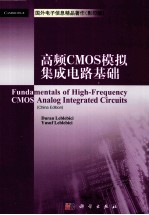

高频CMOS模拟集成电路基础 英文版PDF电子书下载
- 电子书积分:12 积分如何计算积分?
- 作 者:DuranLeblebici著
- 出 版 社:北京:科学出版社
- 出版年份:2011
- ISBN:9787030315199
- 页数:302 页
1 Components of analog CMOS ICs 1
1.1 MOS transistors 1
1.1.1 Current-voltage relations of MOS transistors 3
1.1.1.1 The basic current-voltage relations without velocity saturation 4
1.1.1.2 Current-voltage relations under velocity saturation 11
1.1.1.3 The sub-threshold regime 15
1.1.2 Determination of model parameters and related secondary effects 19
1.1.2.1 Mobility 20
1.1.2.2 Gate capacitance 20
1.1.2.3 Threshold voltage 21
1.1.2.4 Channel length modulation factor 23
1.1.2.5 Gate length(L)and gate width(W) 24
1.1.3 Parasitics of MOS transistors 25
1.1.3.1 Parasitic capacitances 26
1.1.3.2 The high-frequency figure of merit 30
1.1.3.3 The parasitic resistances 31
1.2 Passive on-chip components 36
1.2.1 On-chip resistors 36
1.2.2 On-chip capacitors 38
1.2.2.1 Passive on-chip capacitors 38
1.2.2.2 Varactors 40
1.2.3 On-chip inductors 43
2 Basic MOS amplifiers:DC and low-frequency behavior 49
2.1 Common source(grounded source)amplifier 49
2.1.1 Biasing 53
2.1.2 The small-signal equivalent circuit 54
2.2 Active transistor loaded MOS amplifier(CMOS inverter as analog amplifier) 63
2.3 Common-gate(grounded-gate)amplifier 68
2.4 Common-drain amplifier(source follower) 70
2.5 The"long tailed pair" 75
2.5.1 The large signal behavior of the long tailed pair 84
2.5.2 Common-mode feedback 88
3 High-frequency behavior of basic amplifiers 95
3.1 High-frequency behavior of a common-source amplifier 97
3.1.1 The R-C load case 99
3.2 The source follower amplifier at radio frequencies 103
3.3 The common-gate amplifier at high frequencies 110
3.4 The"cascode"amplifier 114
3.5 The CMOS inverter as a transimpedance amplifier 118
3.6 MOS transistor with source degeneration at high frequencies 126
3.7 High-frequency behavior of differential amplifiers 129
3.7.1 The R-C loaded long tailed pair 129
3.7.2 The fully differential,current-mirror loaded amplifier 132
3.7.3 Frequency response of a single-ended output long tailed pair 136
3.7.4 On the input and output admittances of the long tailed pair 141
3.8 Gain enhancement techniques for high-frequency amplifiers 143
3.8.1 "Additive"approach:distributed amplifiers 144
3.8.2 Cascading strategies for basic gain stages 146
3.8.3 An example:the"Cherry-Hooper"amplifier 148
4 Frequency-selective RF circuits 155
4.1 Resonance circuits 156
4.1.1 The parallel resonance circuit 156
4.1.1.1 The quality factor of a resonance circuit 160
4.1.1.2 The quality factor from a different point of view 163
4.1.1.3 The"Q enhancement" 164
4.1.1.4 Bandwidth of a parallel resonance circuit 168
4.1.1.5 Currents of L and C branches of a parallel resonance circuit 169
4.1.2 The series resonance circuit 170
4.1.2.1 Component voltages in a series resonance circuit 172
4.2 Tuned amplifiers 172
4.2.1 The common-source tuned amplifier 173
4.2.2 The tuned cascode amplifier 179
4.3 Cascaded tuned stages and the staggered tuning 181
4.4 Amplifiers loaded with coupled resonance circuits 189
4.4.1 Magnetic coupling 189
4.4.2 Capacitive coupling 194
4.5 The gyrator:a valuable tool to realize high-value on-chip inductances 194
4.5.1 Parasitics of a non-ideal gyrator 197
4.5.2 Dynamic range of a gyrator-based inductor 201
4.6 The low-noise amplifier(LNA) 202
4.6.1 Input impedance matching 203
4.6.2 Basic circuits suitable for LNAs 207
4.6.3 Noise in amplifiers 210
4.6.3.1 Thermal noise of a resistor 212
4.6.3.2 Thermal noise of a MOS transistor 213
4.6.4 Noise in LNAs 224
4.6.5 The differential LNA 234
5 L-C oscillators 237
5.1 The negative resistance approach to L-C oscillators 237
5.2 The feedback approach to L-C oscillators 245
5.3 Frequency stability of L-C oscillators 249
5.3.1 Crystal oscillators 251
5.3.2 The phase-lock technique 253
5.3.3 Phase noise in oscillators 255
6 Analog-digital interface and system-level design considerations 259
6.1 General observations 259
6.2 Discrete-time sampling 263
6.3 Influence of sampling clock jitter 265
6.4 Quantization noise 267
6.5 Converter specifications 268
6.5.1 Static specifications 269
6.5.2 Frequency-domain dynamic specifications 273
6.6 Additional observations on noise in high-frequency ICs 275
Appendix A Mobility degradation due to the transversal field 277
Appendix B Characteristic curves and parameters of AMS 0.35 micron NMOS and PMOS transistors 279
Appendix C BSIM3-v3 parameters of AMS 0.35 micron NMOS and PMOS transistors 281
Appendix D Current sources and current mirrors 287
D.1 DC current sources 287
D.2 Frequency characteristics of basic current mirrors 289
D.2.1 Frequency characteristics for normal saturation 291
D.2.2 Frequency characteristics under velocity saturation 292
References 293
Index 297
- 《女丹仙道:道教女子内丹养生修炼秘籍 下》董沛文著 2012
- 《卓有成效的管理者 中英文双语版》(美)彼得·德鲁克许是祥译;那国毅审校 2019
- 《民国时期医药卫生文献集成 37》路丽明编 2019
- 《AutoCAD 2018自学视频教程 标准版 中文版》CAD/CAM/CAE技术联盟 2019
- 《民国时期医药卫生文献集成 19》路丽明编 2019
- 《民国时期医药卫生文献集成 24》路丽明编 2019
- 《跟孩子一起看图学英文》张紫颖著 2019
- 《集成曲谱金集 卷7 卷8》黄天骥总主编;王季烈,刘富梁辑 2018
- 《通信电子电路原理及仿真设计》叶建芳 2019
- 《AutoCAD机械设计实例精解 2019中文版》北京兆迪科技有限公司编著 2019
- 《中风偏瘫 脑萎缩 痴呆 最新治疗原则与方法》孙作东著 2004
- 《水面舰艇编队作战运筹分析》谭安胜著 2009
- 《王蒙文集 新版 35 评点《红楼梦》 上》王蒙著 2020
- 《TED说话的力量 世界优秀演讲者的口才秘诀》(坦桑)阿卡什·P.卡里亚著 2019
- 《燕堂夜话》蒋忠和著 2019
- 《经久》静水边著 2019
- 《魔法销售台词》(美)埃尔默·惠勒著 2019
- 《微表情密码》(波)卡西亚·韦佐夫斯基,(波)帕特里克·韦佐夫斯基著 2019
- 《看书琐记与作文秘诀》鲁迅著 2019
- 《酒国》莫言著 2019
- 《指向核心素养 北京十一学校名师教学设计 英语 七年级 上 配人教版》周志英总主编 2019
- 《《走近科学》精选丛书 中国UFO悬案调查》郭之文 2019
- 《北京生态环境保护》《北京环境保护丛书》编委会编著 2018
- 《中医骨伤科学》赵文海,张俐,温建民著 2017
- 《美国小学分级阅读 二级D 地球科学&物质科学》本书编委会 2016
- 《指向核心素养 北京十一学校名师教学设计 英语 九年级 上 配人教版》周志英总主编 2019
- 《强磁场下的基础科学问题》中国科学院编 2020
- 《小牛顿科学故事馆 进化论的故事》小牛顿科学教育公司编辑团队 2018
- 《小牛顿科学故事馆 医学的故事》小牛顿科学教育公司编辑团队 2018
- 《高等院校旅游专业系列教材 旅游企业岗位培训系列教材 新编北京导游英语》杨昆,鄢莉,谭明华 2019
